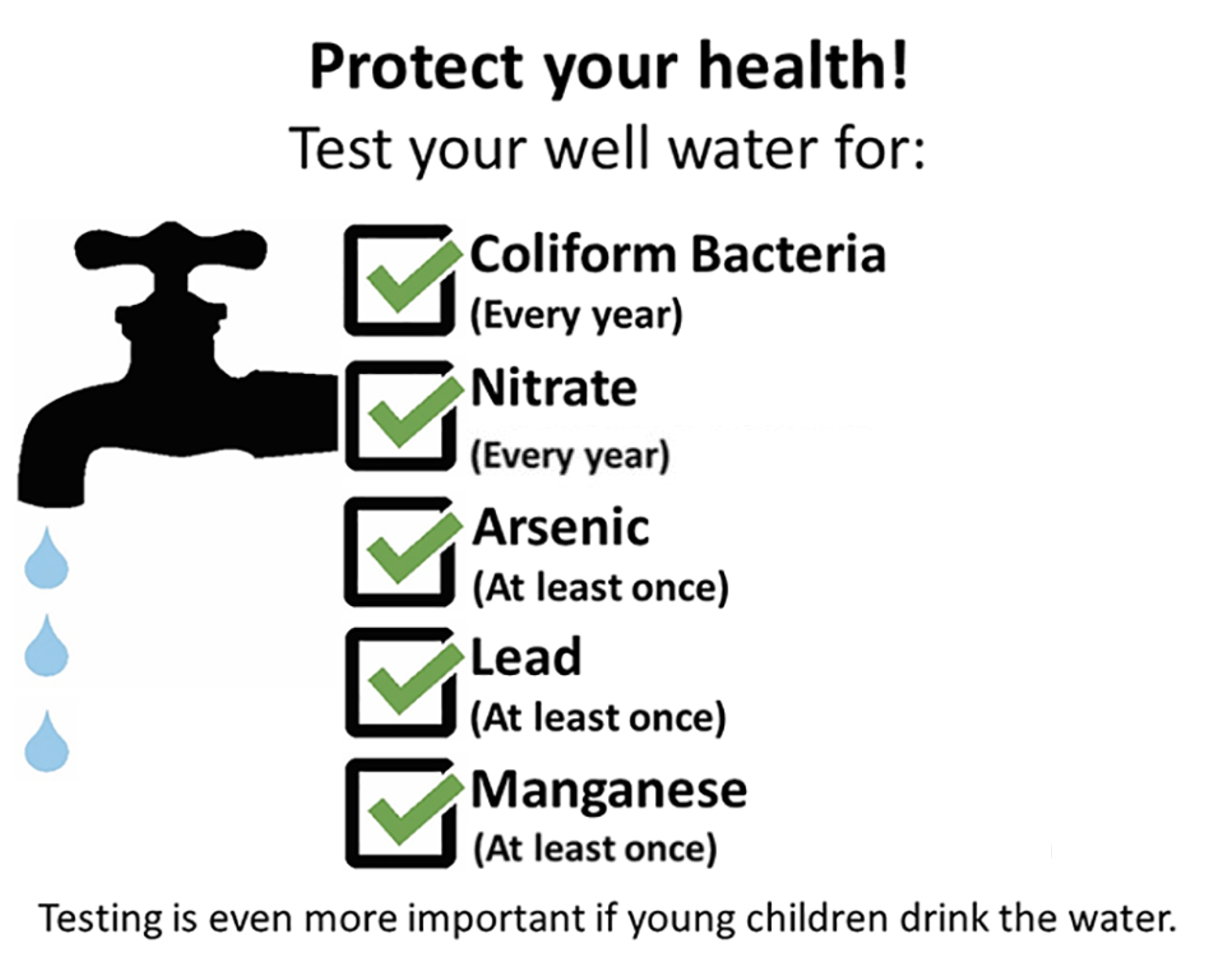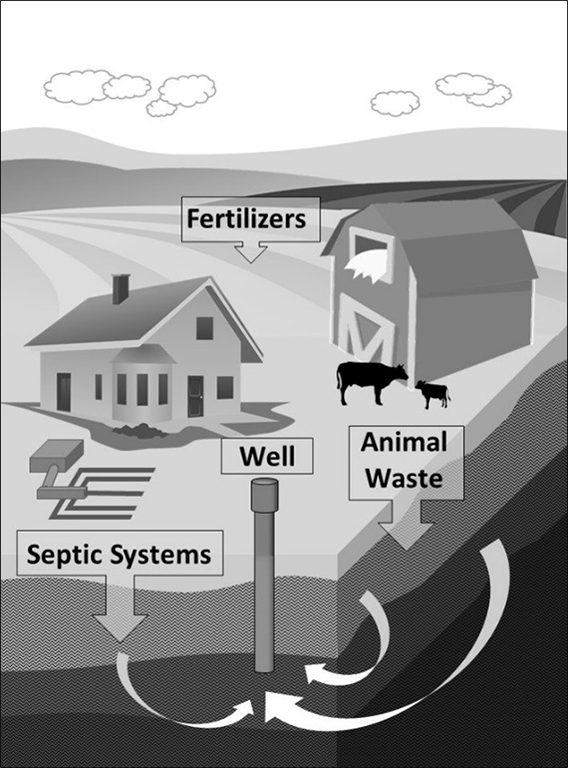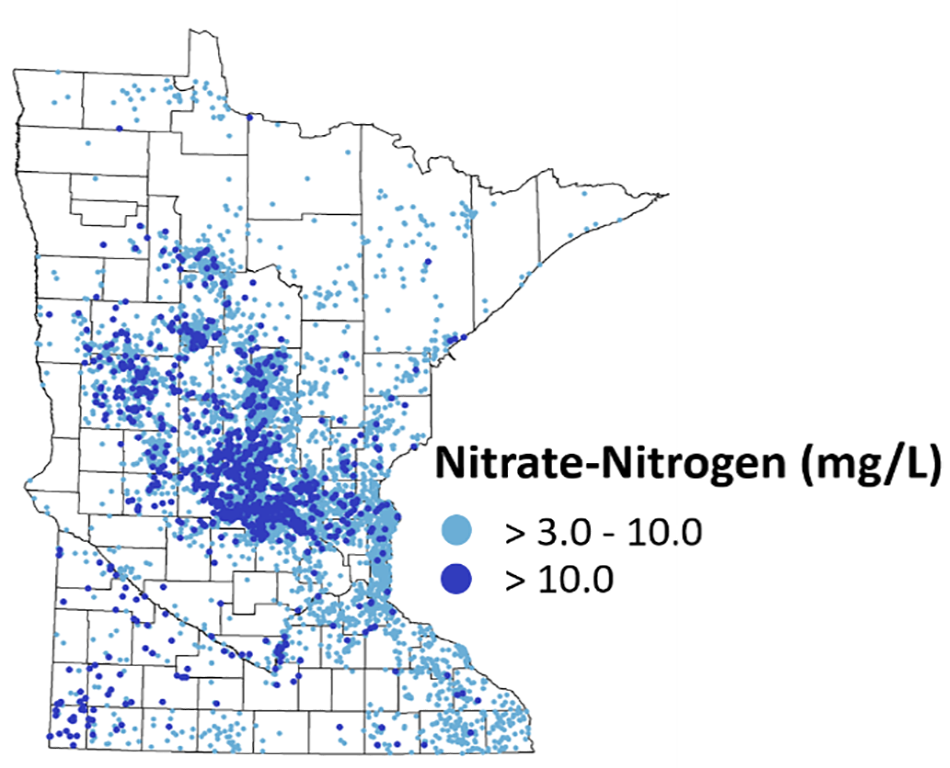...............................................................................................................................................................
Minnesota
Department of Health
Well Management Program
Well Management Program
Nitrate
is in some lakes, rivers, and groundwater in Minnesota.
When
nitrate is found in Minnesota groundwater, it is usually at very low
concentrations.
However,
some groundwater has nitrate concentrations that present a health risk -
especially for babies.
You
cannot taste, see, or smell nitrate in your water.
Safe Level
Drinking
water with concentrations of nitrate (measured as nitrate-nitrogen) below
10 milligrams of nitrate per liter of water (mg/L) is considered safe for
everyone in your family.
10 mg/L
is the U.S. Environmental Protection Agency standard for nitrate in drinking
water for public water supplies.
Health Risks
Consuming
too much nitrate can affect how blood carries oxygen and can cause
methemoglobinemia (also known as blue baby syndrome).
Bottle-fed
babies under six months old are at the highest risk of getting
methemoglobinemia.
Methemoglobinemia
can cause skin to turn a bluish color and, left untreated, can result in
serious illness or death.
The
following conditions may also put people at higher risk of developing
nitrate-induced methemoglobinemia: anemia, cardiovascular disease, lung
disease, sepsis, glucose-6-phosphate-dehydrogenase deficiency, and some
metabolic problems.
Only
recently has scientific evidence emerged to assess the health impacts of
drinking water with high nitrate on adults.
A growing
body of literature indicates potential associations between nitrate/nitrite
exposure and other health effects such as increased heart rate, nausea,
headaches, and abdominal cramps.
.
Some studies also suggest an increased risk of cancer, especially gastric cancer, associated with dietary nitrate/nitrite exposure, but there is not yet scientific consensus on this question.
.
Some studies also suggest an increased risk of cancer, especially gastric cancer, associated with dietary nitrate/nitrite exposure, but there is not yet scientific consensus on this question.
Test Your Well Water
Test for
nitrate every other year. You should also have your water tested for
nitrate if you planning on becoming pregnant or if infants will be using the
water.
You are
responsible for keeping your well water safe and testing it as needed.
MDH
recommends you use an accredited laboratory to test your water.
.
Contact an accredited laboratory to get sample containers and instructions, or ask your county environmental or public health services if they provide well testing services (Accredited Labs in Minnesota Accepting Samples from Private Well Owners [PDF]).
.
Contact an accredited laboratory to get sample containers and instructions, or ask your county environmental or public health services if they provide well testing services (Accredited Labs in Minnesota Accepting Samples from Private Well Owners [PDF]).
Go
to Well Testing, Results, and Options to
learn more about testing well water.
MDH may
recommend you test for additional contaminants based on where you live.
Prevent Contamination
· Keep nitrate sources away from your well. Sources
may include fertilizer, septic systems, and animal waste.
· Construct your well in a safe spot.
· Regularly inspect your well for damage. Contact
a licensed well contractor if your well is damaged (Licensed Well and Boring Contractor Directory).
Wells Vulnerable to
Nitrate
· Shallow wells.
· Wells in sand aquifers.
· Dug wells with casings that are not watertight.
· Wells with damaged or leaking casing or fittings.
Drinking
water with concentrations of nitrate above 10 mg/L can cause immediate health
problems.
If
nitrate is detected in your water at concentrations above 10 mg/L, follow
these steps:
· Get your drinking water from a safe alternative source, such as
bottled water.
· Make sure babies under six months old do not drink the well
water.
· Do not try to boil nitrate out of the water. Boiling will make
nitrate more concentrated.
· Have a licensed well contractor inspect your well.
· Find and get rid of any potential sources of nitrate
contamination. The Protecting Your Well webpage can help you
identify sources to check.
· Home water treatment may be an option if you meet these three
criteria:
1. You took
steps to reduce or eliminate all potential sources of nitrate on your property;
2. A
licensed well contractor inspected your well and completed any needed repairs;
and
3. No babies
under six months old drink the water (a safety precaution in the event the
water treatment fails).
See
the Home Water Treatment webpage or contact
MDH for guidance.
How Nitrate Gets Into
Groundwater
Nitrate
occurs naturally and at safe and healthy levels in some foods (such as spinach
and carrots) and comes from natural processes, such as plant decay.
Nitrate
is in many fertilizers used on yards, golf courses, and crops. Other sources of
nitrate include discharge from sewage systems and animal wastes.
Natural
levels of nitrate in Minnesota groundwater are usually quite low (less than 3
milligrams per liter [mg/L]).
However,
where sources of nitrate such as fertilizers, animal wastes, or human sewage
are concentrated near the ground surface, nitrate may seep down and contaminate
the groundwater.
High
levels of nitrate in water can be a result of runoff or leakage from fertilized
soil, wastewater, landfills, animal feedlots, septic systems, or urban
drainage.
It can be
difficult to pinpoint where the nitrate in drinking water comes from because
there are many possibilities.
Nitrate in Minnesota
Water
About 4
percent of new wells have nitrate concentrations above 3 mg/L in Minnesota.
While 3 mg/L is less than the EPA standard, it suggests human-made sources of
nitrate have contaminated the water and the level could increase over time.
Most
concentrations above 3 mg/L are in central and southeastern Minnesota.
Concentrations above 10 mg/L are mainly in central and southwestern Minnesota.
The
Minnesota Department of Agriculture Township Testing Program found that over
10 percent of the private wells sampled in some townships in southwestern,
southeastern, central, and north-central Minnesota have nitrate levels above 10
mg/L.
Should I test my well
water for anything besides lead?
Yes. Both
natural sources and human activities can contaminate well water and cause
short-term or long-term health effects.
 Testing
your well water is the only way to detect most of the common contaminants in
Minnesota groundwater; you cannot taste, see, or smell most contaminants.
Minnesota Department of Health recommends testing for:
Testing
your well water is the only way to detect most of the common contaminants in
Minnesota groundwater; you cannot taste, see, or smell most contaminants.
Minnesota Department of Health recommends testing for:
· Coliform bacteria every year and
any time the water changes in taste, odor, or appearance. Coliform bacteria can
indicate that disease-causing microorganisms may be in your water.
· Arsenic at least once. About 40 percent of wells in
Minnesota have arsenic in the water.
Drinking
water with arsenic in it for a long time can contribute to reduced intelligence
in children and increased risks of cancer, diabetes, heart disease, and skin
problems.
Lead at least once. The well and water system may have parts that have lead in them, and that lead can get into drinking water. Lead can damage the brain, kidneys, and nervous system. Lead can also slow development or cause learning, behavior, and hearing problems.
Manganese before a baby drinks the water. High levels of manganese can cause problems with memory, attention, and motor skills. It can also cause learning and behavior problems in infants and children.
Other contaminants sometimes occur in private water systems, but less often than the contaminants listed above. Consider testing for:
Lead at least once. The well and water system may have parts that have lead in them, and that lead can get into drinking water. Lead can damage the brain, kidneys, and nervous system. Lead can also slow development or cause learning, behavior, and hearing problems.
Manganese before a baby drinks the water. High levels of manganese can cause problems with memory, attention, and motor skills. It can also cause learning and behavior problems in infants and children.
Other contaminants sometimes occur in private water systems, but less often than the contaminants listed above. Consider testing for:
· Volatile organic chemicals if
the well is near fuel tanks or a commercial or industrial area.
· Agricultural chemicals commonly used in the area if
the well is shallow and is near cropped fields or handling areas for
agricultural chemicals or is in an area of geologic sensitivity (such as
fractured limestone).
· Fluoride if children or
teenagers drink the water.
Minnesota
Department of Health



No comments:
Post a Comment